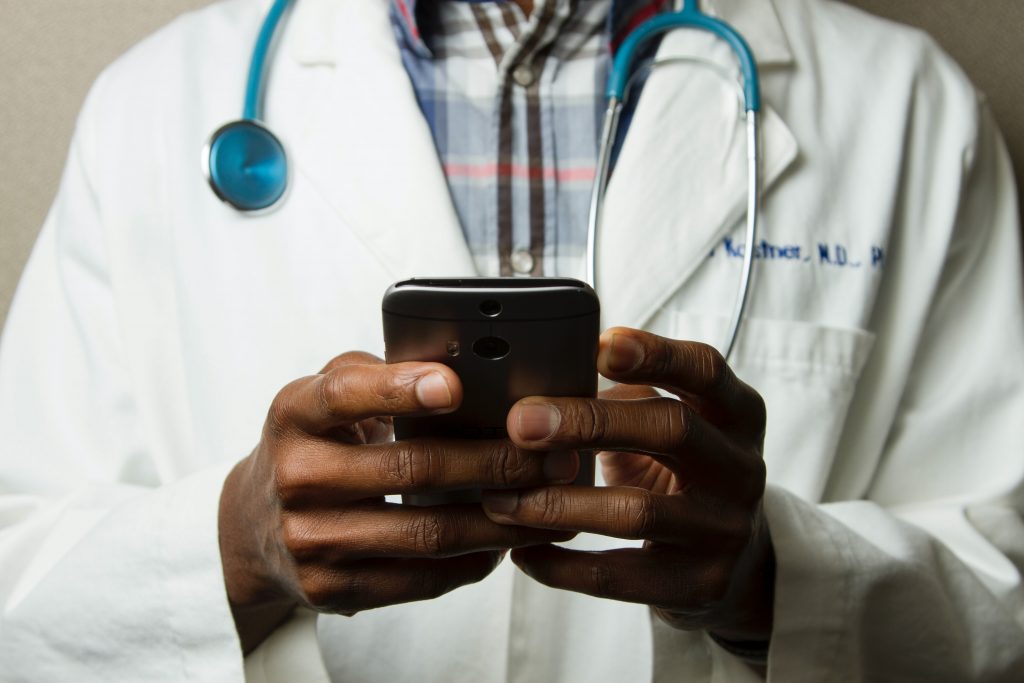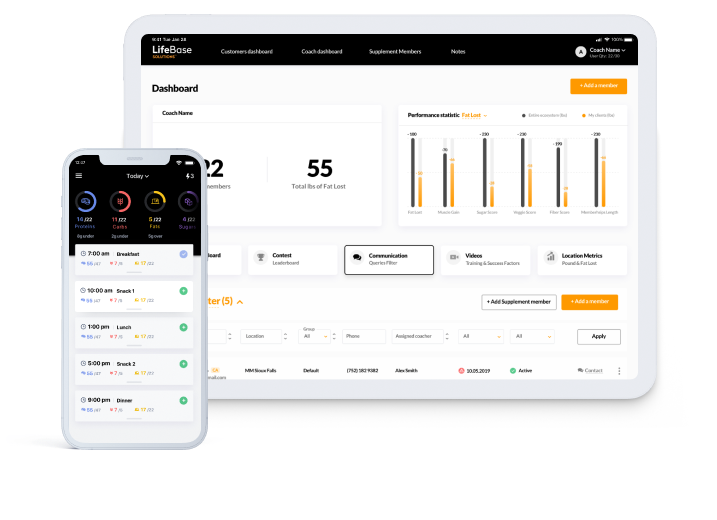Digitalisation in healthcare services
While other industries can afford to measure the success of their software in relation to sales conversions, upgrades, time-in-app or even click through rates, when it comes to the healthcare industry, the core metrics to be improved can be directly related to patient outcomes. Which is to say that a well made digital tool, (even if it’s administrative rather than directly health related) can save lives!
There are a lot of apps on the market which help users keep tabs on their health by tracking heart rate, monitoring blood pressure and notifying of issues that require immediate action. There are even some healthtech offerings out there that aim to save lives directly. PulsePointRespond for example is an app that uses GPS to connect CPR-trained community members who are prepared to act in a cardiac emergency with those encountering such emergencies. This enables people to deliver life saving help before the emergency services arrive on the scene.
The convergence of web technology and modern medical practice has triggered a wave of ground-breaking healthcare industry software that has revolutionised the way patients are managed and treated by enabling simple, accurate diagnostic and organisational tools.
Technology doesn’t have to be flashy to have an impact either. One of the trends to come out of this health tech movement is apps for the management of electronic medical records (EMR) and electronic health records (EHR). According to a report by GVR, the EHR app segment dominated the healthcare digital market in 2020, with a revenue share of over 40% due to increased demand for better EHR and EHR-integrated tools.
All this is to say that the health tech market is big (valued at $74.2 billion in 2020), and expected to keep on growing as new, innovative ways to improve healthcare outcomes with technology are developed.
mHealth benefits
Healthcare software can add value for all stakeholders in the industry: patients, clinical specialists and the health organisations they’re involved with.
For patients
- Fast access to medical care and providers
- No need to bring physical documents to a doctor’s appointment.
- Patients can create digital files of their medical history and share it with the specialists they want.
- Improvement of decision making, reminders, clinical alerts and healthcare information.
- Secured patient billing process
- Online interaction with a doctor without a need to have an appointment in person
- Monitor symptoms in real-time for prompt diagnosis and feedback from a specialist
- Effective accuracy of diagnoses treatment with multiple physicians involved
- Within integrated variables the system can even predict certain conditions or patient critical events. (heart rate apps, sugar level in the blood etc
For Clinical Specialists
- Efficient storing and tracking clinical documentation and patient details
- Decrease of misfiling and errors
- Customized approach for treating each patient
- More focus on treating patients rather than on administrative tasks
- Facilitating communication with colleagues across the healthcare systems using secure messaging
- Automation of medicine prescription
For Health Organizations
- Ability to manage and keep tabs on the organizations processes from anywhere
- Effective staff management
- Increased performance quality of medical workers while automating routine medical processes
- Convenient e-prescriptions sent to the pharmacy electronically
- Send alerts when it’s time to drug purchase
- Quick data sharing between departments
- Cost efficiency for account of paperless solutions and automation of administrative tasks
- Automate and facilitate clinical research
- Ensure higher level of service and boost client satisfaction
Creating a digital strategy for your new healthcare software
Given the wide range of benefits to be had and the overall growth of the health tech sector (not to mention the fact that you’re reading this blog post), it’s likely you’re considering creating a new health tech product. When you’re looking towards MVP development, we’d always advise starting the process with a discovery phase to identify your goals and target audience, set up a realistic roadmap, and avoid costly mistakes.
Target audience.
Identifying who your target audience is essential to build a successful software. Initially, define the type of users who are going to use your application. It might be medical professionals (clinicians, nurses, healthcare organizations, providers) who use software for work purposes or patients using medical tools for personal needs.
Further, you can come up with a detailed user portrait. Usually it looks like a detailed description of the person who is likely to use your product – gender, age, location, income and other characteristics that may be relevant for product creation. Understanding your target audience and their needs will dramatically improve the app design, development and marketing strategies.
Market analysis and competitor research
The market of mobile healthcare is overwhelmed with different solutions. Very often medical apps just copy one another and therefore bring no value to potential users. It happens because of market information ignorance and poor research of competitive products. That is why you need to primarily define product value – specific customer problems your product is going to solve.
A common reason for poor final product is the preliminary study which is based only on medical specialists’ and patients’ surveys. The problem is that doctors and patients sometimes don’t know their real needs and are not aware of all possible solutions available. That is why we recommend running research to study your competitors in the market, comparing their feature set, monetization model etc.
There are big chances other apps already implemented the functionality that fits your product concept so there’s no need reinventing the wheel. Decide what features can help you to stand out from other solutions on the market. The key goal of market analysis is to come up with a concept which is useful, unique, and potentially profitable.
Determine omni-channel strategy.
To provide a cohesive user experience for your customers, you need to think about various channels you will use to interact with your audience. It involves digital marketing channels, online experiences, point-of-sale, customer support. Your omni-channel strategy should include a plan to create a smooth experience across different platforms and devices. Your approach should be flexible and adopted for different types of users – ranging from social media login and email marketing to reaching users out by phone or in-app chat.
Define the strategy framework you will focus on
To create a great product you need to primarily decide on a single crucial metric which guides you and your team. You can, for instance, stick to the North Star Metric or any other strategy framework that will identify the success. This metric should be understandable, measurable, actionable, express value and represent your product’s strategy, vision and goals. If your team will connect customer success to the chosen success metric, you have more chances to lead your business the right path.
Choose a monetization model in advance.
Almost all digital products are created to bring a return. To achieve best results you need to pick up a monetization model that will match your product. For healthcare apps, there are several wide-spread solutions;
- In-app advertising. The application is totally free, but it contains ads for гіукі
- Freemium. The app is free but some functionality can unlocked via in-app purchases
- Subscription. The whole app or premium features are available only on a subscription basis. Users must for a subscription on a weekly, monthly or yearly basis.
- Paid. Users need to pay to get the app
Decide on Functional Structure
Feature set of your healthcare software fully depends on the target audience it’s planned for (patients, clinicians or healthcare organizations). Based on the target audience you need to understand their problems and come up with features that will address those specific problems .
Features and functions are also dependent on the type of app you’re going to develop. For example, MVP development of a heart disease-related mobile app will typically include features like recommendations for daily routines, appointment booking, chat with a doctor, finding medicine vendors and alike.
The functional structure will further determine the technology stack you’re going to use, UI and UX design, app (user-side) development, backend (server side) development, testing, maintenance. Don’t try to cover too much functionality at once. Concentrate on the core features to start with and validate the whole app concept. Find what functions will be most beneficial and don’t take too much development time.
Test your MVP, Validate the idea
To begin with, let’s identify what MVP is. Minimal viable product or MVP is an app which has a basic set of features allowing it to satisfy users’ needs. The goal of MVP is to test the viability of your product concept and a need for an app before investing in full-scale application development. Yet, the MVP should not be of lower quality than a final product, as it still needs to satisfy customer’s needs.
After you run the ideation phase, you can move to actual design, development and iterations stages.
Your next steps should be:
- UI and UX design and wireframes
- Developing key features
- Rolling out the MVP
- Collecting feedback
- Adjusting the product based on the gained insights
Analytics
Сhecking analytics is just as important as gathering comments and insights from users. Numbers don’t lie. Here’s what you need to monitor:
- Keep in mind the strategy framework you chose and monitor a corresponding metric.
- Check key app performance metrics: user satisfaction, crashes, application and server CPU usage, etc. It will give information on software performance and reveal any serious issues.
- Define marketing KPIs and keep checking if your marketing channels and advertisement works effectively. Stick to the plan but don’t be afraid to be flexible based on the results you get
- Check business performance to make sure your product is profitable: monthly recurring revenue (MRR), lifetime value (LTV), churn rate, and other quantitative data.
ASO and Digital Marketing
One of the most critical ways of promoting your app is app store optimization (ASO). The main goal is to maximize your keywords in the app name, facilitate your app’s visibility in app store and drive more downloads. ASO helps you find a relevant audience and push your app’s unique selling point.
Digital marketing might also include:
- Pay per click marketing – Google Ads. Create different campaigns to be run across the funnel – target users from Awareness to Conversion stages.
- Facebook/Instagram ads – growing your brand via running paid Facebook/Instagram ad campaigns
- Content Marketing – valuable information via video, blogs, articles about your domain
- Inbound and Outbound strategies
- Marketing Automation
- Emails and newsletter – onboarding and promotional campaigns as well as relevant healthcare-related information
- Social media marketing – building community of people who’re interested in your product and share educative content, videos, user stories and reviews
- Customer Support – email, phone support or in-app chat for any questions and inquiries
SLA
A service-level agreement (SLA) determines the level of services you expect from a development team. In this document you plan metrics by which service is measured and penalties in case the agreed upon service is not carried out. An SLA is a common element of healthcare development contracts. SLAs usually include service elements like a commitment to specific quality standards for code and deliverables, service/cost tradeoffs as well as, definitions of measurement standards, reporting and dispute resolution processes and other management elements. It also implies an ongoing commitment to the maintenance of the product to ensure it remains optimised for performance and security, and compatible with any changes in environment.
HIPAA regulations
Keep in mind that the healthcare industry is very strict regarding compliance with different legal and privacy regulations. Each country has its own regulations you should be aware of and take care of before releasing your healthcare-related software. In the USA you have to comply with the Health Insurance Portability and Accountability Act HIPAA. It aims to ensure the app security from third parties and the users’ medical records.
To be HIPAA compliant, you need to:
- use unique user authentication to protect user account
- encrypt the personal data which is stored and shared
- automatically log the users off after some period of inactivity
- erase all protected personal data in case the device is stolen or lost
- ensure regular app updates to keep it protected
- automatic data backup if a device is lost
Integration within the healthcare ecosystem
A new paradigm, known as the Internet of Things (IoT) is gaining more applicability in the healthcare sector. Among the most popular hardware-integrated software are smart thermometers, connected inhalers, smartwatch monitoring, wearable biosensors and much more. Consider your app integration with other healthcare wearables. For instance, you can parse data from wearable devices or other healthcare applications such as Apple Health or Google Fit via those medical software tools native APIs.
At Ekreative we developed a personal nutrition platform that synchronized with a body composition analyser (smart weight). This integration made our solution unique on the market and enabled maximum results for customers.
For healthcare companies, it may be useful to integrate a new app into existing software within the company’s ecosystem to easily share in-house information. Bigger corporations might benefit from building whole software systems within the organization that will facilitate the workflow, reduce time and costs.
Most common failure reasons
There are multiple reasons why healthcare IT projects fail. Usually, it’s a combination of several factors. The most common mistakes are:
- The product doesn’t solve a particular problem. People download mHealth apps to solve a specific healthcare-related problem. If the app doesn’t provide a real benefit for users, it’s worthless and won’t generate profit.
- Insufficient ROI. Very often healthcare projects are too expensive and require advanced solutions to meet the goals. Some projects turn out to be not in line with the initial requirements, they exceed the budget and therefore fail to meet the ROI. Another reason is the wrong monetization strategy.
- Poor marketing. Even the best products can collapse because of the wrong marketing strategies. Inadequate marketing strategies can be fatal for the outcomes
- Lack of expert involvement. One of the most dangerous omissions of a healthcare app is the lack of collaboration with medical professionals. Be aware that providing users with non-science-based content may potentially be harmful. Consider looking for a medical expert consultation while making digital healthcare products.
Developing reliable and successful healthcare software
Making a medical app is a great technical and business challenge, with a lot of potential for growth and return. But it’s so much more than that! Progress in this area is an essential element of the drive to improve healthcare outcomes and make a real difference, improving quality of life and saving peoples lives! That’s why healthcare apps are always going to be in demand, and why here at Ekreative we’re eager to take on new projects in this industry and add to our existing deep experience of developing healthcare software of all kinds. When we’re empowering healthcare focussed companies with robust, HIPAA compliant, data-driven solutions, we’re playing to our strengths and making a difference.



